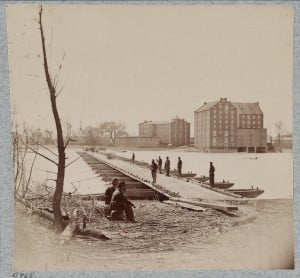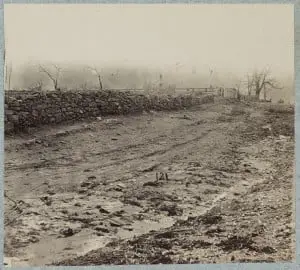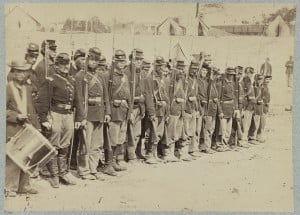December 11th – 15th 1862
The Battle of Fredericksburg was a decisive Confederate victory. Union General Ambrose Burnside assumed command of the Army of the Potomac on November 9th 1862.
He replaced General George B. McClellan who was relieved of duty after failing to pursue Robert E. Lee and his Army of Northern Virginia after the Union victory at the Battle of Antietam in September 1862.
President Abraham Lincoln wanted an aggressive commander that would take the war south and directly attack the Confederate capital of Richmond, Virginia and win the war.
Lincoln ordered General McClellan to attack Richmond, however McClellan had many excuses and refused to move his army so he was removed from command. General Burnside did not want to make the same mistake as McClellan.
Burnside’s goal was to be aggressive and attack the Confederates immediately, striking toward Richmond to seize the capital and win the war as President Lincoln had ordered.
After assuming command General Burnside formed the Army of the Potomac into three grand divisions. On November 16th Union Major General Joseph Hooker assumed command of the Center Grand Division, Major General Edwin Sumner took command of the Right Grand Division and Major General William Franklin took command of the Left Grand Division of the Army of the Potomac.
Burnside quickly began to move his army south. In order to get to Richmond he first needed to cross the Rappahannock River and take Fredericksburg, Virginia.
The Plan for the Battle of Fredericksburg
On arriving at the banks of the Rappahannock across from Fredericksburg, Burnside expected to have pontoon boats for building bridges and gunboats to protect the crossing waiting for him. Neither of these were there when he arrived.
Eventually Burnside received the pontoon boats and was able to cross the river without much trouble. This delay however, allowed General Robert E. Lee time to reinforce and dig in his army on Marye’s Heights outside of Fredericksburg.
General Hooker and General Sumner were to cross the Rappahannock and capture Fredericksburg, they would then launch a frontal assault against the heavily entrenched Confederate army west of town on Marye’s Heights.
Meanwhile General Franklin would cross the Rappahannock several miles south of Fredericksburg, his mission was to attack the Confederates in their right flank and roll up their line inflicting a crushing defeat against the rebels.
On paper the plan was not a bad idea, and it could work if it was carried out correctly.
Confusion and Defeat at Fredericksburg
On December 13th 1862 the Center and Right divisions of the Army of the Potomac began their frontal attack against the Confederate positions on Marye’s Heights.
However General Burnside gave vague and confusing orders to the left wing under General Franklin.
General Franklin was unsure what he was suppose to do. Instead of smashing into Lee’s right flank he sent out some reconnaissance patrols and did nothing else during the battle.
This meant the two grand divisions under Hooker and Sumner were left unsupported while they attacked a heavily defended force.
The initial Union assault was quickly repulsed by the Confederates. General Burnside ordered another attack which was also repulsed, he then ordered more attacks each being driven back as easily as the first.
It was during one of these failed assaults that Robert E. Lee remarked to General James Longstreet that “it is well that war is so terrible otherwise we should grow to fond of it”.
Without the supporting flank attack the Union army had no chance of success. At 5:30pm Burnside finally decided to call it quits.
He quickly abandoned the town of Fredericksburg and recrossed the Rappahannock River, giving General Robert E. Lee a much needed victory against the Union army.
Aftermath of the Battle of Fredericksburg
Fredericksburg was a humiliating defeat for the Union. President Lincoln quickly realized that General Burnside was no match for a superior general like Robert E. Lee and he was not up to the task of leading the largest and most powerful army in the Union.
On January 25th 1863 General Ambrose Burnside was relieved of command of the Army of the Potomac.
He was replaced by General Joseph Hooker.
General Burnside again command troops during the Siege of Petersburg in 1864. He would be responsible for another blunder at the Battle of the Crater where many more Union soldiers would be gravely wounded and killed because of his poor command decisions.


































